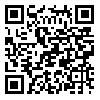دوره 10، شماره 1 - ( 10-1402 )
جلد 10 شماره 1 صفحات 14-3 |
برگشت به فهرست نسخه ها
Download citation:
BibTeX | RIS | EndNote | Medlars | ProCite | Reference Manager | RefWorks
Send citation to:



BibTeX | RIS | EndNote | Medlars | ProCite | Reference Manager | RefWorks
Send citation to:
Azarang Z, Farahaninia M, Bozorgnezhad M, Haghani H. Relationship Between Health Literacy and Addiction Susceptibility in High School Adolescents. JCCNC 2024; 10 (1) :3-14
URL: http://jccnc.iums.ac.ir/article-1-359-fa.html
URL: http://jccnc.iums.ac.ir/article-1-359-fa.html
Relationship Between Health Literacy and Addiction Susceptibility in High School Adolescents. نشریه مراقبت پرستاری مددجو محور. 1402; 10 (1) :3-14
چکیده: (1863 مشاهده)
Background: Adolescence is a high-risk period. Teenagers experience risky behaviors in this period, including using abusive drugs and addiction. Meanwhile, sufficient awareness helps a person to interpret and analyze health-threatening factors. This study aimed to determine the relationship between health literacy and susceptibility to addiction in adolescents living in the western part of Tehran City, Iran.
Methods: This descriptive-correlational study was performed on 265 senior high school students in the western part of Tehran in 2021. The subjects were recruited by cluster random sampling. The study data were collected online using the addiction susceptibility questionnaire and health literacy measure for adolescents. The obtained data were sorted by frequency distribution, Mean±SD and analyzed utilizing the Pearson correlation coefficient, independent t-test, and analysis of variance in SPSS software, version 16. The significance level was set at 0.05.
Results: Most study subjects (56.4%) were female. Their Mean±SD score of health literacy was 65.31±21.15. Among the subscales of health literacy, “calculation”, with a Mean±SD score of 68.96±35.89, and “utilization”, with 61.29±25.05, had the highest and lowest mean scores, respectively. The Mean±SD score of addiction susceptibility was 25.3±30.05, and among its subscales, “showing off” with a mean score of 33.09±32.64 and “family dissatisfaction” with 19.75±35.47 had the highest and lowest mean scores, respectively. Health literacy and its dimensions had a negative correlation with addiction susceptibility (P<0.001).
Conclusion: According to the findings, it is recommended to use appropriate strategies to increase adolescent health literacy by health service providers, school officials, school health nurses, and teachers. The results of this study can be used as a source for further research on addiction and health literacy in adolescents.
| بازنشر اطلاعات | |
 |
این مقاله تحت شرایط Creative Commons Attribution-NonCommercial 4.0 International License قابل بازنشر است. |





